| ________________
CM . . . . Volume XVII Number 14. . . .December 3, 2010. 
 |
It is My Birthday. (My World).
Bobbie Kalman.
St. Catharines, ON: Crabtree, 2010.
16 pp., pbk. & hc., $6.95 (pbk.), $15.16 (RLB.).
ISBN 978-0-7787-9462-2 (pbk.), ISBN 978-0-7787-9418-9 (RLB.).
Subject Heading:
Birthday parties-Juvenile literature.
Kindergarten-grade 1 / Ages 5-6.
Review by Carrie Subtelny.
***/4
|
| |
|
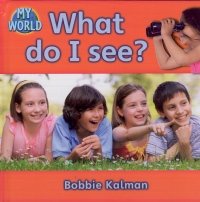 |
What do I See? (My World).
Bobbie Kalman.
St. Catharines, ON: Crabtree, 2010.
16 pp., pbk. & hc., $6.95 (pbk.), $15.16 (RLB.).
ISBN 978-0-7787-9463-9 (pbk.), ISBN 978-0-7787-9419-6 (RLB.).
Subject Heading:
Vision-Juvenile literature.
Kindergarten-grade 1 / Ages 5-6.
Review by Carrie Subtelny.
***/4
|
| |
|
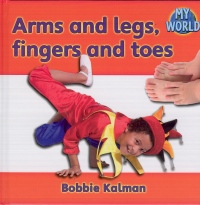 |
Arms and Legs, Fingers and Toes. (My World).
Bobbie Kalman.
St. Catharines, ON: Crabtree, 2010.
16 pp., pbk. & hc., $6.95 (pbk.), $15.16 (RLB.).
ISBN 978-0-7787-9460-8 (pbk.), ISBN 978-0-7787-9416-5 (RLB.).
Subject Heading:
Extremities (Anatomy)-Juvenile literature.
Kindergarten-grade 1 / Ages 5-6.
Review by Carrie Subtelny.
***/4
|
| |
|
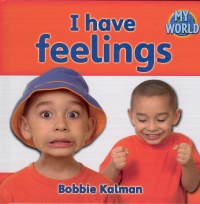 |
I Have Feelings. (My World).
Bobbie Kalman.
St. Catharines, ON: Crabtree, 2010.
16 pp., pbk. & hc., $6.95 (pbk.), $15.16 (RLB.).
ISBN 978-0-7787-9461-5 (pbk.), ISBN 978-0-7787-9417-2 (RLB.).
Subject Heading:
Emotions-Juvenile literature.
Kindergarten-grade 1 / Ages 5-6.
Review by Carrie Subtelny.
***/4
|
| |
|
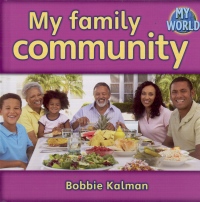 |
My Family Community. (My World).
Bobbie Kalman.
St. Catharines, ON: Crabtree, 2010.
24 pp., pbk. & hc., $7.95 (pbk.), $18.36 (RLB.).
ISBN 978-0-7787-9485-1 (pbk.), ISBN 978-0-7787-9441-7 (RLB.).
Subject Heading:
Families-Juvenile literature.
Kindergarten-grade 1 / Ages 5-6.
Review by Carrie Subtelny.
***/4
|
| |
|
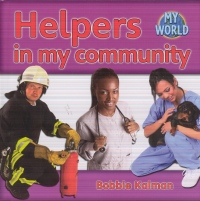 |
Helpers in My Community. (My World).
Bobbie Kalman.
St. Catharines, ON: Crabtree, 2010.
24 pp., pbk. & hc., $7.95 (pbk.), $18.36 (RLB.).
ISBN 978-0-7787-9488-2 (pbk.), ISBN 978-0-7787-9444-8 (RLB.).
Subject Headings:
Community life-Juvenile literature.
Professions-Juvenile literature.
Kindergarten-grade 1 / Ages 5-6.
Review by Carrie Subtelny.
***/4
|
| |
|
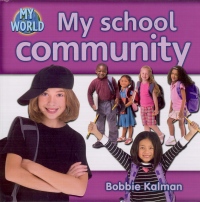 |
My School Community. (My World).
Bobbie Kalman.
St. Catharines, ON: Crabtree, 2010.
24 pp., pbk. & hc., $7.95 (pbk.), $18.36 (RLB.).
ISBN 978-0-7787-9486-8 (pbk.), ISBN 978-0-7787-9442-4 (RLB.).
Subject Heading:
Schools-Juvenile literature.
Kindergarten-grade 1 / Ages 5-6.
Review by Carrie Subtelny.
***/4
|
| |
|
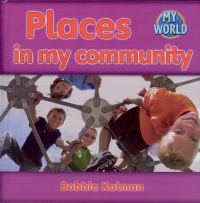 |
Places in My Community. (My World).
Bobbie Kalman.
St. Catharines, ON: Crabtree, 2010.
24 pp., pbk. & hc., $7.95 (pbk.), $18.36 (RLB.).
ISBN 978-0-7787-9487-5 (pbk.), ISBN 978-0-7787-9443-1 (RLB.).
Subject Headings:
Communities-Juvenile literature.
Community life-Juvenile literature.
Kindergarten-grade 1 / Ages 5-6.
Review by Carrie Subtelny.
*/4
|
| |
|

excerpt:
Soon it will be Grandma’s birthday! Sofia wants to make her a birthday card. Sofia’s mom helps gather materials. They look for shapes to put along the borders of the card.
They move the shapes in different ways to see how the shapes look. Sofia’s mom tells her about transformations. The different ways a shape can be moved on a flat surface are called transformations. (From Slides, Flips, and Turns.)
Crabtree has published a set of levelled texts authored by Bobbie Kalman. The Fountas and Pinnell levelling system was used as the guide for levelling this series. The source chosen for levelling is important to note as descriptive reading behaviours can vary up to two grade levels, depending on the system chosen. Emergent readers use text to accelerate their early reading behaviours; thus, it is integral that books/text match their stages of intended development. Text structures, text features, word repetition, grammar, vocabulary and amount of print per page are some of the considerations to which authors must pay attention when crafting texts that intentionally consider “aspects of the reader” (Kibby, 1986).
The series “My World” was looked at for this review. Four texts were issued at Level B (mid kindergarten to beginning grade 1) and four at Level G (end of grade 1). Level B books according to levelling criteria outlined by Fountas and Pinnell should include some or most of the following: (1) 3-8 words per line (4-5 words on average); (2) one line per page, (3) 30-55 words in total, (4) complete sentences on each page, (5) repetition of high frequency words, (6) 2-3 high frequency words per page, (7) repetitive pattern that may change on the last page, (8) familiar topic, (9) predictable language, (10) consistent print placement. The criteria for Level G books can be described as having some or most of the following: (1) 2-12 words per line, (2) 2-7 lines per page, (3) 120-200 words in total, (4) complete sentences, (5) simple sentences with prepositional phrases and introductory clauses, (6) repetition of high frequency words, (7) predictable language and patterns, (8) illustration labels in non-fiction text, (9) simple tables and charts, (10) text features - table of contents, index, glossary, (11) high text/picture correspondence, (12) text placement can vary, (13) approximately 12 pages.
The theme of It’s My Birthday (Level B) is perfect for this stage of reading development. The pictures included in this book are beautiful and realistic. Vibrant colours are captured and depict a warm, celebratory event. When considering the criteria for texts at this level, the lines per page are not consistent. Additionally, the total number of words (30-55) is not achieved. The text does not have a consistent, repetitive pattern, nor is the text placement consistent. Considering the support a reader needs at this stage of literacy development, teacher scaffolding will be critical for a student to feel success with this book.
What Do I See? (Level B) seems to be a better match for the reader at this stage. Once again photos are realistic and natural. There is good word patterning and predictability. However the last two pages seem “text heavy” with demanding word choice for the reader – “Do you see a young girl sleeping inside a seashell?” (p. 14). “Is she really there? I will never tell!” (p. 15).
The repetitive pattern of word choice is clearly present in Arms and Legs, Fingers and Toes (Level B). However, the text on page 7, “The boy is holding the ball with his ankle,” is not consistent with Level B criteria. The number of words requires the reader to use a ‘return sweep’ since text placement is altered. In addition to the “Body Parts” listed on the “Words to Know” page, I am wondering if “Action Words” could also be considered as the reader (kindergarten to beginning grade 1) is supposed to know words like pointing, bending, holding, punching, and learning. The inclusion of both genders in the ballet photos is excellent. However, even though the photos throughout the book capture brilliant expressions, I’m not sure they help support the reader with accurate decoding.
I Have Feelings (Level B) has many of the features required to consider it a Level B text. There is predictable language throughout, and the text includes a word pattern to prompt readers. The topic is also familiar for most children. However, the number of lines of print/page is not consistent, nor is text placement. Once again, the photos that are used as illustrations create good associations for the reader; however, the “angry” picture looks more like smirking! Finally, on pages 12 and 13, the author writes, “I like these feelings. I do not like these feelings.” As a parent and educator, I would prefer to see that children are encouraged to know that all feelings are okay and that sometimes feeling uncomfortable helps us become stronger in character and self. Once again, scaffolding will be needed to read and engage with the latter pages of this text, especially when picture support on these pages doesn’t clearly show the feelings listed.
The next sets of books were considered as Level G texts. Throughout these texts, I would suggest that the “Words to Know” title now state “Glossary” and that a true index be included in this group to better match the criteria of LG. All of the texts at this level present topics that will invite many great dialogues about community. Readers at this stage are learning how to use different text features to build their comprehension skills, in addition to the ongoing consolidation of strategic reading behaviours.
Helpers in My Community (Level G) includes features that meet the following criteria: a familiar topic is explored, a table of contents is included, there are 2-12 words per line, 2-7 lines per page; there are bold words inserted as well as labels. The photos are consistent with the lower levelled text; however, the reader is now required to use the print rather than the photo to decode and comprehend. For example, when plumbers are introduced as community helpers, the photo shows a boy in a bubble bath. Similarly, on the page referencing school helpers, there is a photo of a school nurse – a position that is rarely seen in a Canadian public school - rather than an office assistant or custodian. The added section on “Kind Helpers” was good to see, and I would suggest to really extend this notion to a broader context with photos showing children helping seniors, photos of people with disabilities giving and/or receiving help and even reading buddies would create a loop back to the school community.
The text features in My Family Community also follow the criteria for Level G. For instance, there is a table of contents, bold words and photo labels. The section that I really liked was from this particular title was “Communities Teach”. The concept and photos send a powerful message of mentoring and encouragement. The inclusion of people with disabilities would have added to this title.
My School Community and Places in my Community are the final two books in this series. It’s important for the author to keep definitions parallel. In My Family Community, a community is defined as “a group of people who live together and care for one another.” In My School Community, “a community is a group of people... [and] a place where people work together and share things.” Most readers will understand the subtle differences, but it’s important to be able to create text to text connections, and the topic of COMMUNITY in this series seems to be designed to explicitly practice this particular comprehension strategy- text to text connections. Because a variety of learners come to each text with diverse background knowledge, consistency and continuity are critical for understanding along with many opportunities for TALK. Our EAL (English as an Additional Language) population, in particular, requires such support.
Another print that is worth noting: “Children of the same age are in a grade” (p. 6, My School Community). However, we must remember that most classrooms (single grade) have students that are, in fact, different ages. Additionally, as educators we hope our students gain knowledge vs. information (p. 12) and that, once again, many schools do not have a school nurse on site.
The brilliant photographs and the sections on health, rules, fun, and cultures provide excellent information for dialogue(and it is in these dialogues that knowledge is created!). The diversity of gender roles and ethnic representation is commendable.
Once again, it is important to note that the inclusion of children and persons with disabilities is, unfortunately, not evident in any of the texts for review (eight in total). However, as stated earlier, different ethnicities, multi-generations, fair representation of gender and family structures are clearly depicted and noted.
The section titled “Words to Know” in all of the texts is a good prompt for vocabulary prediction. My hope is that this choice will provide the teacher with the foundation to step towards teaching students about glossaries and text features such as bold print and italics.
Recommended.
A reading clinician, teacher and mother, Carrie Subtelny resides in Winnipeg, MB.

To comment on this title or this review, send mail to
cm@umanitoba.ca.
Copyright © the Manitoba Library Association. Reproduction for personal use is permitted only if this copyright notice is maintained. Any other reproduction is prohibited without permission.
NEXT REVIEW |
TABLE OF CONTENTS FOR THIS ISSUE- December 3, 2010.
AUTHORS |
TITLES |
MEDIA REVIEWS |
PROFILES |
BACK ISSUES |
SEARCH |
CMARCHIVE |
HOME |







